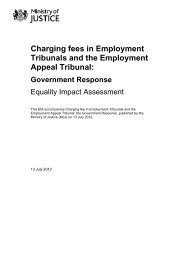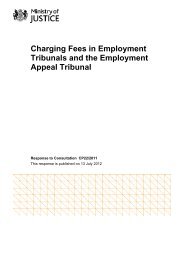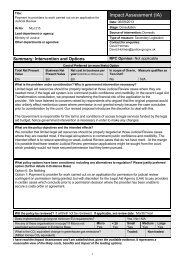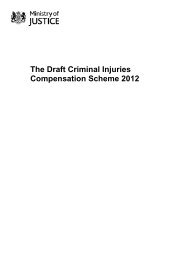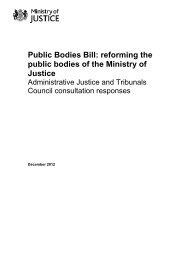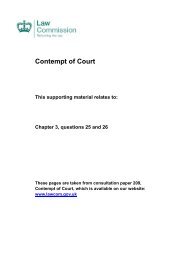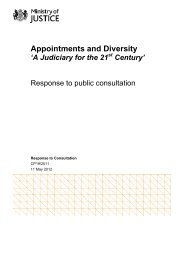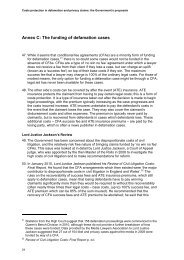Proposed reforms to attachment of earnings orders - Ministry of Justice
Proposed reforms to attachment of earnings orders - Ministry of Justice
Proposed reforms to attachment of earnings orders - Ministry of Justice
Create successful ePaper yourself
Turn your PDF publications into a flip-book with our unique Google optimized e-Paper software.
if so, how significant they might be. Given this we have assumed that the overall impact on<br />
legal aid, if any, is unlikely <strong>to</strong> be significant.<br />
2. Costs & Benefits<br />
2. 1 This Impact Assessment identifies both monetised and non-monetised impacts on individuals,<br />
groups and businesses in the UK, with the aim <strong>of</strong> understanding what the overall impact <strong>to</strong><br />
society might be from implementing the options considered. The costs and benefits <strong>of</strong> each<br />
option are compared <strong>to</strong> the do nothing option. Impact Assessments place a strong emphasis on<br />
valuing the costs and benefits in monetary terms (including estimating the value <strong>of</strong> goods and<br />
services that are not traded). However there are important aspects that cannot sensibly be<br />
monetised which might include how the proposals impact differently on particular groups <strong>of</strong><br />
society or changes in equity and fairness.<br />
2. 2 This impact assessment considers the impacts on the above groups under the different options<br />
for enforcing aspects <strong>of</strong> the TCE Act ’07 in relation <strong>to</strong> <strong>attachment</strong> <strong>of</strong> <strong>earnings</strong> <strong>orders</strong>.<br />
Option 0: Base case (do nothing)<br />
2. 3 Under this option, no intervention would be made. Therefore, methods <strong>to</strong> obtain information<br />
about deb<strong>to</strong>rs and the calculation for <strong>earnings</strong> deductions would be undertaken in the same way<br />
as now, relying on court staff <strong>to</strong> individually calculate each AEO order depending on the<br />
information provided by the deb<strong>to</strong>r. In particular, information about a deb<strong>to</strong>r’s employer when an<br />
AEO fails (as the deb<strong>to</strong>r has changed employer) can only be obtained through requesting this<br />
from the deb<strong>to</strong>r (and not from HMRC). This may involve repeated involvement <strong>of</strong> the court and<br />
the use <strong>of</strong> bailiffs, resulting in unnecessary delay and which remains subject <strong>to</strong> the deb<strong>to</strong>r’s<br />
engagement. The base case would also allow current arrangements <strong>to</strong> continue whereby<br />
employers are obliged <strong>to</strong> use two different procedures for deducting from <strong>earnings</strong>.<br />
2. 4 All options are assessed relative <strong>to</strong> the base case. As such, the costs or benefits associated with<br />
the base case are necessarily zero.<br />
Option 1: Introduce fixed tables calculations for <strong>earnings</strong> deductions in <strong>attachment</strong> <strong>of</strong><br />
<strong>earnings</strong> <strong>orders</strong> (TCE Act ’07 – Section 91)<br />
Description<br />
2. 5 Under the current system for judgment debts in the County Court, the court relies on the deb<strong>to</strong>r's<br />
completion <strong>of</strong> a means form (N56) <strong>to</strong> calculate a Protected Earnings Rate (PER) and a Normal<br />
Deduction Rate (NDR). This <strong>of</strong>ten leads <strong>to</strong> unnecessary delay. Some deb<strong>to</strong>rs do not return the<br />
means form when asked <strong>to</strong> do so. If it is not returned after 14 days, a County Court bailiff must<br />
serve the documents personally on the deb<strong>to</strong>r and this may require several visits <strong>to</strong> the deb<strong>to</strong>r's<br />
address before documents can be served. There can also be issues surrounding the reliability <strong>of</strong><br />
the information supplied by deb<strong>to</strong>rs.<br />
2. 6 Introducing fixed tables setting out deductions at fixed rates for AEOs made by the County Court<br />
<strong>to</strong> secure a judgment debt would remove the need for a means form <strong>to</strong> be completed. Once the<br />
court has made an order the employer would be instructed <strong>to</strong> apply the deduction rate specified<br />
as a percentage <strong>of</strong> the <strong>to</strong>tal applicable <strong>earnings</strong> in the tables. The deb<strong>to</strong>r would still have 14 days<br />
<strong>to</strong> respond once the order has been made, but after that time the deductions would begin<br />
au<strong>to</strong>matically. The aim is <strong>to</strong> make the process more straightforward at the court end, and<br />
therefore <strong>to</strong> speed up the process.<br />
2. 7 With fixed deductions tables employers would also have a system that provides more certainty<br />
and is more consistent with other the deduction schemes they operate in relation <strong>to</strong> Council Tax<br />
and unpaid fines.<br />
2. 8 Fixed tables would specify, given the deb<strong>to</strong>r’s net pay over a certain pay period, the percentage<br />
<strong>of</strong> their salary that would be deducted each period <strong>to</strong> pay for the debt. There would be a lower<br />
limit (<strong>to</strong> be determined in secondary legislation) meaning that those who earn below a certain<br />
8





